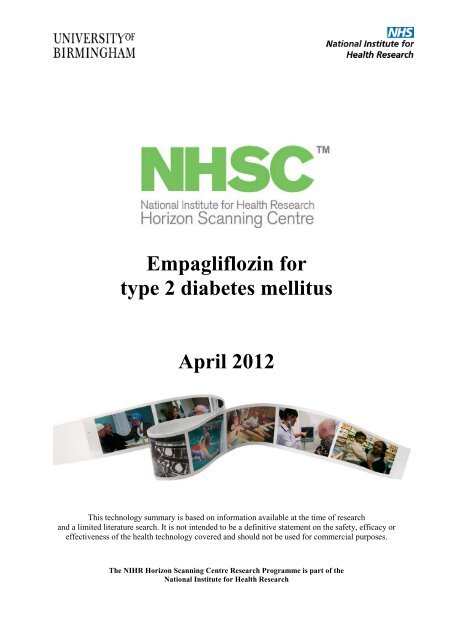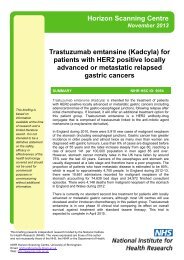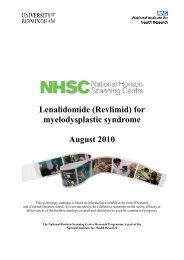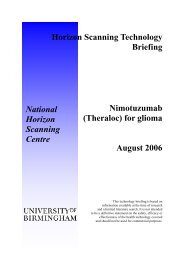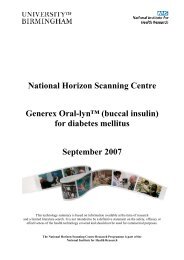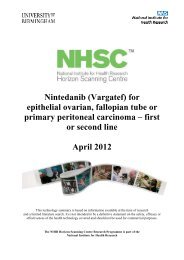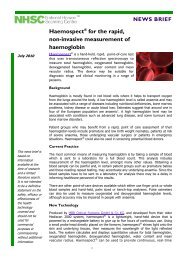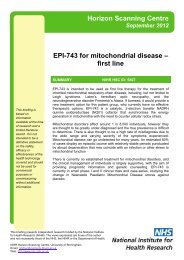Empagliflozin for type 2 diabetes mellitus - National Horizon ...
Empagliflozin for type 2 diabetes mellitus - National Horizon ...
Empagliflozin for type 2 diabetes mellitus - National Horizon ...
You also want an ePaper? Increase the reach of your titles
YUMPU automatically turns print PDFs into web optimized ePapers that Google loves.
<strong>Empagliflozin</strong> <strong>for</strong><br />
<strong>type</strong> 2 <strong>diabetes</strong> <strong>mellitus</strong><br />
April 2012<br />
This technology summary is based on in<strong>for</strong>mation available at the time of research<br />
and a limited literature search. It is not intended to be a definitive statement on the safety, efficacy or<br />
effectiveness of the health technology covered and should not be used <strong>for</strong> commercial purposes.<br />
The NIHR <strong>Horizon</strong> Scanning Centre Research Programme is part of the<br />
<strong>National</strong> Institute <strong>for</strong> Health Research
April 2012<br />
Target group<br />
• Type 2 <strong>diabetes</strong> <strong>mellitus</strong>.<br />
<strong>Empagliflozin</strong> <strong>for</strong> <strong>type</strong> 2 <strong>diabetes</strong> <strong>mellitus</strong><br />
Technology description<br />
<strong>Empagliflozin</strong> (BI-10773) is a sodium glucose co-transporter <strong>type</strong> 2 (SGLT-2) inhibitor.<br />
It acts by blocking renal glucose re-absorption from the renal filtrate, thereby increasing<br />
urinary glucose excretion. SGLT-2 inhibitors are also associated with weight loss and<br />
reductions in blood pressure. <strong>Empagliflozin</strong> is intended to treat and improve the<br />
glycaemic control of adults with <strong>type</strong> 2 <strong>diabetes</strong> <strong>mellitus</strong>. In the phase III clinical trial,<br />
empagliflozin was administered orally at 10mg or 25mg once daily 1<br />
.<br />
<strong>Empagliflozin</strong> is in phase III clinical trials <strong>for</strong> patients with <strong>type</strong> 2 <strong>diabetes</strong> and<br />
hypertension, a high risk of cardiovascular events or renal impairment, and is in phase II<br />
clinical trials <strong>for</strong> <strong>type</strong> 1 <strong>diabetes</strong>.<br />
Innovation and/or advantages<br />
If licensed, empagliflozin would offer an additional oral treatment option <strong>for</strong> patients with<br />
<strong>type</strong> 2 <strong>diabetes</strong> <strong>mellitus</strong>.<br />
Developer<br />
Boehringer-Ingelheim.<br />
Availability, launch or marketing dates, and licensing plans<br />
In phase III clinical trials.<br />
NHS or Government priority area<br />
This topic is relevant to The <strong>National</strong> Service Framework <strong>for</strong> Diabetes (2007).<br />
Relevant guidance<br />
• NICE technology appraisal. Exenatide prolonged-release suspension <strong>for</strong> injection with<br />
oral antidiabetic therapy <strong>for</strong> the treatment of <strong>type</strong> 2 <strong>diabetes</strong>. 2012 2<br />
.<br />
• NICE technology appraisal. Liraglutide <strong>for</strong> the treatment of <strong>type</strong> 2 <strong>diabetes</strong> <strong>mellitus</strong>.<br />
3<br />
2010 .<br />
• NICE technology appraisal. Continuous subcutaneous insulin infusion <strong>for</strong> the<br />
4<br />
treatment of <strong>diabetes</strong> <strong>mellitus</strong>. 2008 .<br />
• NICE technology appraisal. Inhaled insulin <strong>for</strong> the treatment of <strong>type</strong> 1 and <strong>type</strong> 2<br />
5<br />
<strong>diabetes</strong>. 2006 .<br />
• NICE technology appraisal. Guidance on the use of long-acting insulin analogues <strong>for</strong><br />
6<br />
the treatment of <strong>diabetes</strong> – insulin glargine. 2002 .<br />
• NICE clinical guideline. Type 2 <strong>diabetes</strong>: the management of <strong>type</strong> 2 <strong>diabetes</strong>. 2008 7<br />
.<br />
• NICE clinical guideline. Diabetes in pregnancy: management of <strong>diabetes</strong> and its<br />
8<br />
complications from pre-conception to the postnatal period. 2008 .<br />
• SIGN. Management of <strong>diabetes</strong>: A national clinical guideline. 2010 9<br />
.<br />
10<br />
• Clinical Knowledge Summaries. Insulin therapy in <strong>type</strong> 2 <strong>diabetes</strong>. 2010 .<br />
11<br />
• Clinical Knowledge Summaries. Diabetes <strong>type</strong> 2. 2008 .<br />
• <strong>National</strong> Collaborating Centre <strong>for</strong> Chronic Conditions. Type 2 <strong>diabetes</strong>: national<br />
12<br />
clinical guideline <strong>for</strong> management in primary and secondary care (update). 2008 .<br />
2
April 2012<br />
Clinical need and burden of disease<br />
The prevalence of <strong>diabetes</strong> in the UK is increasing, but not accurately known, and varies<br />
with factors including age, ethnic group and social deprivation 8,12 . In 2010, the prevalence<br />
of <strong>diabetes</strong> (diagnosed and undiagnosed) in adults was estimated to be 7.4% a in England,<br />
which equates to 3,009,853 people above the age of 16 years 13 . In Wales, the prevalence<br />
was estimated to be 9% b , equating to 218,956 people above the age of 16 years 14 . More<br />
than 85% of people with <strong>diabetes</strong> are expected to have <strong>type</strong> 2 <strong>diabetes</strong> and in 2009 it was<br />
estimated that there were 821,800 adults in England with <strong>diabetes</strong> who were not<br />
diagnosed 6,15<br />
. The prevalence of <strong>diabetes</strong> among adults is estimated to rise to 8.5% by<br />
2020 and 9.5% by 2030 15 .<br />
In England in 2005, there were 26,300 deaths between the ages of 20 and 79 years which<br />
were registered as due to <strong>diabetes</strong> (11.6% of all deaths in this age group) 16 . However,<br />
clinical coding practice means that only a minority of deaths among people with <strong>diabetes</strong><br />
from causes that can be associated with the disease have <strong>diabetes</strong> identified as the<br />
primary cause of death 15 . Life expectancy is reduced by up to 10 years in this patient<br />
group 17 . Cardiovascular disease is a common complication of <strong>type</strong> 2 <strong>diabetes</strong> and a<br />
significant cause of death and disability, accounting <strong>for</strong> around 52% of all deaths from<br />
<strong>diabetes</strong> 18 . Other long-term complications associated with <strong>diabetes</strong> include: nephropathy,<br />
retinopathy and neuropathy, leading respectively to renal failure, reduced vision or<br />
blindness, and foot ulceration and amputation 19<br />
.<br />
Existing comparators and treatments<br />
Current treatment options, alone or in combination, include 7,20,21<br />
:<br />
Oral antidiabetic drugs<br />
• Met<strong>for</strong>min – first line.<br />
• Sulfonylureas: gliclazide, glibenclamide, glipizide, tolbutamide, glimepiride.<br />
• DPP-4 inhibitors: sitagliptin, vildagliptin, saxagliptin, linagliptin.<br />
• Thiazolidinediones (glitazones): pioglitazone.<br />
• Alpha-glucosidase inhibitors: acarbose.<br />
Injectable antidiabetic drugs<br />
• Short-acting insulin.<br />
• Long-acting (basal) insulin.<br />
• Insulin secretagogues: liraglutide c<br />
, exenatide.<br />
Current practice is that treatment with any agent other than insulin or sulphonylureas should<br />
aim to reduce the HbA1c d level to as low as 6.5%. Treatment with insulin or sulphonylureas<br />
should aim to achieve a target HbA1c level of ≥ 7% to avoid the risk of hypoglycaemia. For<br />
longer duration patients and those with co-morbidities such as cardiovascular disease and/or<br />
renal impairment, a target of 7.5% is recommended e<br />
. Current NICE guidelines recommend a<br />
target HbA1c of
April 2012<br />
Efficacy and safety<br />
Trial NCT01177813, 2009-<br />
016243-20, 1245.20;<br />
empagliflozin vs placebo<br />
vs sitagliptin; phase III.<br />
NCT01159600, 2009-<br />
016258-41, 1245.23;<br />
empagliflozin vs placebo,<br />
both with met<strong>for</strong>min<br />
alone or in combination<br />
with a sulfonylurea; phase<br />
III.<br />
Boehringer Ingelheim<br />
Pharmaceuticals.<br />
Complete but<br />
unpublished.<br />
.<br />
NCT01368081, 1245.52;<br />
empagliflozin with an oral<br />
antidiabetic drug vs<br />
met<strong>for</strong>min; phase III.<br />
Sponsor Boehringer Ingelheim<br />
Boehringer Ingelheim<br />
Pharmaceuticals.<br />
Pharmaceuticals.<br />
Status Complete but<br />
unpublished.<br />
Ongoing.<br />
Source of<br />
in<strong>for</strong>mation<br />
Trial registry 1 . Trial registry 22<br />
23<br />
Trial registry<br />
Location EU, USA, Canada, India, EU, USA, Canada and Japan.<br />
China and Japan. other countries.<br />
Design Randomised, active- and Randomised, placebo- Randomised, active-<br />
placebo-controlled. controlled.controlled.<br />
Participants n=986 (planned); adults; n=1,504; adults; <strong>type</strong> 2 n=1,122 (planned), 20 years<br />
and schedule <strong>type</strong> 2 <strong>diabetes</strong> <strong>mellitus</strong>; <strong>diabetes</strong> <strong>mellitus</strong>; and older; <strong>type</strong> 2 <strong>diabetes</strong><br />
drug naive; HbA1c ≥7% insufficient glycaemic <strong>mellitus</strong>; pre-treated with an<br />
and ≤10%.<br />
control; pre-treatment oral anti-diabetic drug;<br />
Randomised to<br />
with met<strong>for</strong>min or HbA1c ≥7% and ≤10%.<br />
empagliflozin, 10mg or met<strong>for</strong>min with a Randomised to<br />
25mg; placebo;<br />
sulfonylurea unchanged empagliflozin, 10mg or<br />
sitagliptin, 100mg; or <strong>for</strong> 12 weeks prior to 25mg oral once daily; or<br />
empagliflozin open-label, randomisation; HbA1c met<strong>for</strong>min, 500-2,250mg,<br />
25mg. All administered ≥7% and ≤11%.<br />
oral daily.<br />
orally once daily. Randomised to<br />
empagliflozin, 10mg or<br />
25mg; or empagliflozin<br />
open-label 25mg; or<br />
placebo. All administered<br />
orally once daily in<br />
combination with<br />
met<strong>for</strong>min ≥1,500mg<br />
daily or met<strong>for</strong>min with a<br />
sulfonylurea,<br />
administered at least half<br />
of the maximum<br />
recommended dose.<br />
Follow-up Active treatment period Active treatment period Active-treatment period 52<br />
24 weeks.<br />
24 weeks.<br />
weeks.<br />
Primary HbA1c. HbA1c. Adverse events (AEs);<br />
outcome<br />
hypoglycaemic events;<br />
protocol specified significant<br />
AEs; cardiovascular events;<br />
change in BP; change in<br />
laboratory values.<br />
Secondary Body weight; systolic and Body weight; mean HbA1c.<br />
outcomes diastolic blood pressure change in daily plasma<br />
(BP).<br />
glucose; target response<br />
(HbA1c
April 2012<br />
Expected<br />
reporting date<br />
Previosuly reported as<br />
Mar 2012.<br />
Trial NCT01210001, 2009-<br />
016154-40, 1245.19;<br />
empagliflozin vs placebo,<br />
both with pioglitazone<br />
alone or with met<strong>for</strong>min;<br />
phase III.<br />
(decrease in HbA1c by<br />
≥0.5%); fasting plasma<br />
glucose (FPG); waist<br />
circumference; BP;<br />
composite endpoint of<br />
decrease in HbA1c by<br />
≥0.5%, decrease in<br />
systolic BP by ≥3mmHg<br />
and decrease in body<br />
weight by >2%.<br />
Previously reported as<br />
Feb 2012.<br />
NCT01167881, 2009-<br />
016244-39, 1245.28;<br />
empagliflozin vs<br />
glimepiride, both with<br />
met<strong>for</strong>min; phase III.<br />
Estimated study completion<br />
date, Mar 2013.<br />
NCT01289990, 2010-<br />
022718-17, 1245.31;<br />
empagliflozin vs placebo,<br />
both with sitagliptin alone or<br />
with different background<br />
therapies; phase III<br />
Sponsor Boehringer Ingelheim Boehringer Ingelheim<br />
extension.<br />
Boehringer Ingelheim<br />
Pharmaceuticals. Pharmaceuticals. Pharmaceuticals.<br />
Status Ongoing. Ongoing. Ongoing.<br />
Source of<br />
in<strong>for</strong>mation<br />
Trial registry 24<br />
.<br />
25<br />
Trial registry .<br />
26<br />
Trial registry .<br />
Location EU, USA, Canada and EU (inc UK), USA, EU, USA, Canada and other<br />
other countries.<br />
Canada and other<br />
countries.<br />
countries.<br />
Design Randomised, placebo- Randomised, active- Non-randomised, active- and<br />
controlled.controlled.<br />
placebo-controlled.<br />
Participants n=468 (planned); adults; n=1,400; adults; <strong>type</strong> 2 n=1,920 (planned); adults;<br />
and schedule <strong>type</strong> 2 <strong>diabetes</strong> <strong>mellitus</strong>; <strong>diabetes</strong> <strong>mellitus</strong>; pre- <strong>type</strong> 2 <strong>diabetes</strong> <strong>mellitus</strong>;<br />
insufficient glycaemic treated with met<strong>for</strong>min 12 completed trials<br />
control; pre-treatment weeks prior to<br />
NCT01210001,<br />
with pioglitazone or randomisation; HbA1c NCT01177813,<br />
pioglitazone with ≥7% and ≤10%.<br />
NCT01159600.<br />
met<strong>for</strong>min unchanged <strong>for</strong> Randomised to<br />
<strong>Empagliflozin</strong> 10mg, 25mg;<br />
12 weeks prior to empagliflozin 25mg; or or placebo, all oral once<br />
randomisation; HbA1c glimepiride 1-4mg, both daily, each arm alone or in<br />
≥7% and ≤10%.<br />
oral once daily with combination with<br />
Randomised to<br />
met<strong>for</strong>min ≥1,500mg pioglitazone, met<strong>for</strong>min,<br />
empagliflozin, 10mg or daily.<br />
met<strong>for</strong>min and sulphonlurea,<br />
25mg; or placebo. All<br />
or sitagliptin monotherapy<br />
administered orally once<br />
daily in combination with<br />
pioglitazone ≥30mg daily,<br />
alone or with met<strong>for</strong>min<br />
≥1,500mg daily,<br />
unchanged throughout<br />
trial.<br />
100mg, oral once daily.<br />
Follow-up Active treatment period Active treatment period Active treatment period<br />
24 weeks.<br />
104 weeks.<br />
minimum of 76 weeks.<br />
Primary HbA1c. HbA1c. Safety; tolerability; AEs;<br />
outcome<br />
changes in<br />
albumin/creatinine ratio; use<br />
of rescue therapy.<br />
5
April 2012<br />
Secondary<br />
outcomes<br />
Expected<br />
reporting date<br />
FPG. Body weight; BP;<br />
hypoglycaemic events;<br />
AEs; cardiovascular<br />
events.<br />
Estimated study<br />
completion date, Apr<br />
2012.<br />
Trial NCT01306214, 2010-<br />
019968-37, 1245.49;<br />
empagliflozin vs placebo,<br />
both with insulin alone or<br />
with met<strong>for</strong>min; phase III.<br />
Sponsor Boehringer Ingelheim<br />
Pharmaceuticals.<br />
Estimated study<br />
completion date, Aug<br />
2015.<br />
NCT01370005, 2011-<br />
000347-25, 1245.48;<br />
empagliflozin vs placebo;<br />
phase III.<br />
HbA1c; body weight; waist<br />
circumference; FPG;<br />
composite endpoint of<br />
decrease in HbA1c by<br />
≥0.5%, decrease in systolic<br />
BP by ≥3mmHg and<br />
decrease in body weight by<br />
>2%; BP.<br />
Estimated study completion<br />
date, Apr 2013.<br />
NCT01164501, 2009-<br />
016179-31, 1245.36;<br />
empagliflozin vs placebo;<br />
phase III.<br />
Boehringer Ingelheim Boehringer Ingelheim<br />
Pharmaceuticals. Pharmaceuticals.<br />
Status Ongoing. Ongoing. Ongoing.<br />
Source of<br />
in<strong>for</strong>mation<br />
Trial registry 27<br />
.<br />
28<br />
Trial registry .<br />
29<br />
Trial registry .<br />
Location EU, USA and other EU, USA, Canada, EU (inc UK), USA, Canada<br />
countries.<br />
Norway and Lebanon. and other countries.<br />
Design Randomised, placebo- Randomised, placebo- Randomised, placebocontrolled.controlled.controlled.<br />
Participants n=555 (planned); adults; n=816 (planned); adults; n=682 (planned); adults; <strong>type</strong><br />
and schedule <strong>type</strong> 2 <strong>diabetes</strong> <strong>mellitus</strong>; <strong>type</strong> 2 <strong>diabetes</strong> <strong>mellitus</strong>; 2 <strong>diabetes</strong>; renal impairment;<br />
pre-treated with multiple hypertension; HbA1c estimated glomerular<br />
daily injections of insulin ≥7.0% and ≤10%; mean filtration rate of
April 2012<br />
Expected<br />
reporting date<br />
Estimated study<br />
completion date, Apr<br />
2013.<br />
with HbA1c 0.5%; fasting<br />
plasma insulin; body weight.<br />
Key results For empagliflozin 1mg, 5mg, 10mg, For empagliflozin 5mg, 10mg, 25mg and<br />
25mg, 50mg and sitagliptin, respectively met<strong>for</strong>min, respectively (p values vs<br />
(p value vs placebo): HbA1c vs placebo, placebo): HbA1c vs placebo, -0.52%, -<br />
-0.24% , -0.39%, -0.71%, -0.70%, - 0.57%, -0.72%, -0.82% (all p
April 2012<br />
effects<br />
(AEs)<br />
Expected<br />
reporting<br />
date<br />
sitagliptin, respectively: frequent<br />
urination, 2.5% vs 1.4% vs 0%; urinary<br />
tract infection, 4.0% vs 2.8% vs 4.2%;<br />
gential infection, 4.0% vs 0% vs 2.8%;<br />
hypoglycaemia, 1.1% vs 0% vs 2.8%.<br />
urination, thirst and nasopharyngitis. Rates of<br />
hypoglycaemia similar between groups. Low<br />
incidence of genital infections and urinary<br />
tract infections.<br />
Previously reported as Oct 2009. Previously reported as Oct 2009.<br />
Trial NCT00881530, 2008-007938-21, 1245.24; adults; empagliflozin vs sitagliptin vs<br />
met<strong>for</strong>min; phase II extension.<br />
Sponsor Boehringer Ingelheim Pharmaceuticals.<br />
Status Completed but unpublished.<br />
Source of<br />
in<strong>for</strong>mation<br />
Trial registry 34 .<br />
Location EU, USA and other countries.<br />
Design Randomised, active-controlled.<br />
Participants<br />
and schedule<br />
n=660 (planned); adults; <strong>type</strong> 2 <strong>diabetes</strong>; completed trial NCT00789035 or<br />
NCT00749190.<br />
Randomised to empagliflozin 10mg or 25mg, oral once daily; or sitagliptin 100mg, oral<br />
once daily; or met<strong>for</strong>min, 2,000mg, oral daily.<br />
Follow-up Active treatment period 78 weeks.<br />
Primary Safety; AEs; hypoglycaemic events; use of rescue therapy; vital signs; body weight;<br />
outcomes waist circumference; lipid parameters; clinical laboratory changes.<br />
Secondary HbA1c; % treated to target
April 2012<br />
Services<br />
Increased use<br />
Costs<br />
Service organisation Staff requirements<br />
Decreased use Other: None identified<br />
Increased unit cost compared to<br />
alternative<br />
New costs: Additional treatment<br />
option.<br />
Increased costs: more patients Increased costs: capital<br />
coming <strong>for</strong> treatment<br />
investment needed<br />
Savings: Other:<br />
Other issues<br />
Clinical uncertainty or other research question identified: Expert opinion<br />
suggests there remains clinical uncertainty regarding the long-term<br />
adverse effects on the kidney, the mechanism of blood pressure lowering<br />
and the increased risk of genital or urinary infections. There are potential<br />
safety concerns in patients who are fluid depleted and careful study will<br />
also be needed following concerns that SGLT-2 inhibitors may increase<br />
the incidence of cancers.<br />
References<br />
None identified<br />
1<br />
ClinicalTrials.gov. Efficacy of BI-10773 versus placebo and sitagliptin over 24 weeks in patients with <strong>type</strong> 2<br />
<strong>diabetes</strong>. http://www.clinicaltrials.gov/ct2/show/NCT01177813?term=NCT01177813&rank=1 Accessed 8<br />
March 2012.<br />
2<br />
<strong>National</strong> Institute <strong>for</strong> Health and Clinical Excellence. Exenatide prolonged-release suspension <strong>for</strong> injection with<br />
oral antidiabetic therapy <strong>for</strong> the treatment of <strong>type</strong> 2 <strong>diabetes</strong>. Technology appraisal. TA248. February 2012.<br />
3<br />
<strong>National</strong> Institute <strong>for</strong> Health and Clinical Excellence. Liraglutide <strong>for</strong> the treatment of <strong>type</strong> 2 <strong>diabetes</strong> <strong>mellitus</strong>.<br />
Technology appraisal TA203. London: NICE; October 2010.<br />
4<br />
<strong>National</strong> Institute <strong>for</strong> Health and Clinical Excellence. Continuous subcutaneous insulin infusion <strong>for</strong> the<br />
treatment of <strong>diabetes</strong> <strong>mellitus</strong>. Technology appraisal TA151. London: NICE; July 2008.<br />
5<br />
<strong>National</strong> Institute <strong>for</strong> Health and Clinical Excellence. Inhaled insulin <strong>for</strong> the treatment of <strong>type</strong> 1 and <strong>type</strong> 2<br />
<strong>diabetes</strong>. Technology appraisal TA113. London: NICE; December 2006.<br />
6<br />
<strong>National</strong> Institute <strong>for</strong> Health and Clinical Excellence. Guidance on the use of long-acting insulin analogues <strong>for</strong><br />
the treatment of <strong>diabetes</strong> – insulin glargine. Technology appraisal TA53. London: NICE; December 2002.<br />
7<br />
<strong>National</strong> institute <strong>for</strong> Health and Clinical Excellence. Type 2 <strong>diabetes</strong>: the management of <strong>type</strong> 2 <strong>diabetes</strong>.<br />
Clinical guideline CG66. London: NICE; May 2008.<br />
8<br />
<strong>National</strong> Institute <strong>for</strong> Health and Clinical Excellence. Diabetes in pregnancy: management of <strong>diabetes</strong> and its<br />
complications from pre-conception to the postnatal period. Clinical guideline CG63. London: NICE; March<br />
2008.<br />
9 Scottish Intercollegiate Guidelines Network. Management of <strong>diabetes</strong>; A national clinical guideline. Edinburgh: SIGN; March 2010.<br />
10 NHS Clinical Knowledge Summaries.<br />
Insulin therapy in <strong>type</strong> 2 <strong>diabetes</strong>. November 2010.<br />
http://www.cks.nhs.uk/insulin_therapy_in_<strong>type</strong>_2_<strong>diabetes</strong><br />
11<br />
NHS Clinical Knowledge Summaries. Diabetes <strong>type</strong> 2. December 2008.<br />
http://www.cks.nhs.uk/<strong>diabetes</strong>_<strong>type</strong>_2<br />
12<br />
<strong>National</strong> Collaborating Centre <strong>for</strong> Chronic Conditions. Type 2 <strong>diabetes</strong>: national clinical guideline <strong>for</strong><br />
management in primary and secondary care (update). London: Royal College of Physicians, 2008.<br />
13<br />
Yorkshire and Humber Public Health Observatory. Diabetes Prevalence Model <strong>for</strong> England.<br />
http://www.yhpho.org.uk/default.aspx?RID=81090 Accessed 14 March 2012.<br />
14<br />
Yorkshire and Humber Public Health Observatory. Diabetes Prevalence Model <strong>for</strong> Wales.<br />
http://www.yhpho.org.uk/default.aspx?RID=81090 Accessed 14 March 2012.<br />
15<br />
Yorkshire and Humber Public Health Observatory. Diabetes Prevalence Model: Key findings <strong>for</strong> England.<br />
YHPHO: June 2010. http://www.yhpho.org.uk/default.aspx?RID=81090 Accessed 8 March 2012.<br />
16<br />
Yorkshire and Humber Public Health Observatory. Diabetes attributable deaths; estimating the excess deaths<br />
among people with <strong>diabetes</strong>. YHPHO: May 2008.<br />
17<br />
Marshall S and Flyvbjerg A. Prevention and early detection of vascular complications of <strong>diabetes</strong>. British<br />
Medical Journal 2006;333:475-480.<br />
18<br />
Diabetes UK. Diabetes in the UK 2010: Key statistics on <strong>diabetes</strong>.<br />
http://www.<strong>diabetes</strong>.org.uk/Documents/Reports/Diabetes_in_the_UK_2010.pdf<br />
19<br />
World Health Organization. Programmes and projects. Diabetes action online.<br />
9
April 2012<br />
http://www.who.int/<strong>diabetes</strong>actiononline/<strong>diabetes</strong>/basics/en/index3.html Accessed 16 March 2012.<br />
20 NICE Pathways. Diabetes. Blood-glucose-lowering therapy <strong>for</strong> <strong>type</strong> 2 <strong>diabetes</strong>.<br />
http://pathways.nice.org.uk/ Accessed 16 March 2012.<br />
21 Diabetes UK. Treatments. http://www.<strong>diabetes</strong>.org.uk/Guide-to-<strong>diabetes</strong>/Treatments/ Accessed 8 March 2012.<br />
22 ClinicalTrials.gov. Efficacy and safety study with BI 10773 vs placebo as add-on to met<strong>for</strong>min or met<strong>for</strong>min<br />
plus sulfonylurea over 24 weeks in patients with <strong>type</strong> 2 <strong>diabetes</strong>.<br />
http://www.clinicaltrials.gov/ct2/show/NCT01159600?term=01159600&rank=1 Accessed 22 March 2012.<br />
23 ClinicalTrials.gov. BI 10773 comprehensive add-on study in Japanese subjects with <strong>type</strong> 2 <strong>diabetes</strong> <strong>mellitus</strong>.<br />
http://www.clinicaltrials.gov/ct2/show/study/NCT01368081?term=01368081&rank=1#locn Accessed 22<br />
March 2012.<br />
24 ClinicalTrials.gov. Efficacy and safety of BI 10773 in <strong>type</strong> 2 <strong>diabetes</strong> patients on a background of pioglitazone<br />
alone or with met<strong>for</strong>min. http://www.clinicaltrials.gov/ct2/show/NCT01210001?term=01210001&rank=1<br />
Accessed 22 March 2012.<br />
25 ClinicalTrials.gov. Efficacy and safety of BI 101773 with met<strong>for</strong>min in patients with <strong>type</strong> 2 <strong>diabetes</strong>.<br />
http://www.clinicaltrials.gov/ct2/show/NCT01167881?term=01167881&rank=1 Accessed 22 March 2012.<br />
26 ClinicalTrials.gov. Safety and efficacy of BI 10773 and sitagliptin versus placebo over 76 weeks in patients<br />
with <strong>type</strong> 2 <strong>diabetes</strong>. http://www.clinicaltrials.gov/ct2/show/NCT01289990?term=01289990&rank=1.<br />
Accessed 22 March 2012.<br />
27 ClinicalTrials.gov. Safety and efficacy of BI 10773 as add-on to insulin regimen in patients with <strong>type</strong> 2<br />
<strong>diabetes</strong> <strong>mellitus</strong>. http://www.clinicaltrials.gov/ct2/show/NCT01306214?term=01306214&rank=1. Accessed<br />
22 March 2012.<br />
28 Clinicaltrials.gov. 12 week efficacy and safety study of BI 10773 in hypertensive patients with <strong>type</strong> 2 <strong>diabetes</strong><br />
<strong>mellitus</strong>. http://www.clinicaltrials.gov/ct2/show/study/NCT01370005?term=NCT01370005&rank=1#locn<br />
Accessed 13 April 2012.<br />
29 ClinicalTrials.gov. Efficacy and safety of BI 10773 in patients with <strong>type</strong> 2 <strong>diabetes</strong> and renal impairment.<br />
http://www.clinicaltrials.gov/ct2/show/study/NCT01164501?term=NCT01164501&rank=1#locn Accessed 13<br />
April 2012.<br />
30 ClinicalTrials.gov. BI 10773 add-on to met<strong>for</strong>min in patients with <strong>type</strong> 2 <strong>diabetes</strong>.<br />
http://www.clinicaltrials.gov/ct2/show/NCT00749190?term=00749190&rank=1 Accessed 22 March 2012.<br />
31 Rosenstock J, Jelaska A, Seman L et al. Efficacy and safety of BI 10773, a new sodium glucose cotransporter-<br />
2 (SGLT-2) inhibitor in <strong>type</strong> 2 <strong>diabetes</strong> inadequately controlled on met<strong>for</strong>min. ADA 2011; Abstract 989.<br />
32 ClinicalTrials.gov. 12 weeks treatment with 3 different doses of BI-10773 in <strong>type</strong> 2 diabetic patients.<br />
http://www.clinicaltrials.gov/ct2/show/NCT00789035?term=NCT00789035&rank=1 Accessed 8 March 2012.<br />
33 Ferrannini E, Seman LJ, Seewaldt-Becker E et al. The potent and highly selective soldium-glucose cotransporter<br />
(SGLT-2) inhibitor BI 10773 is safe and effacious monotherapy in patients with <strong>type</strong> 2 <strong>diabetes</strong><br />
<strong>mellitus</strong>. ESAD 2010; Abstract 877.<br />
34 ClinicalTrials.gov. BI-10773 in <strong>type</strong> two <strong>diabetes</strong> (T2D) patients, open label extension.<br />
http://www.clinicaltrials.gov/ct2/show/NCT00881530?term=NCT00881530&rank=1 Accessed 8 March 2012.<br />
35 British Medical Association and Royal Pharmaceutical Society of Great Britain. British <strong>National</strong> Formulary.<br />
BMJ Group and RPS Publishing. London; March 2012.<br />
The <strong>National</strong> Institute <strong>for</strong> Health Research <strong>Horizon</strong> Scanning Centre Research Programme is<br />
funded by the Department of Health.<br />
The views expressed in this publication are not necessarily those of the NHS, the NIHR or the<br />
Department of Health<br />
The NIHR <strong>Horizon</strong> Scanning Centre,<br />
Department of Public Health and Epidemiology<br />
University of Birmingham, 90 Vincent Drive, Edgbaston, Birmingham, B15 2SP, England<br />
Tel: +44 (0)121 414 7831 Fax +44 (0)121 414 2269<br />
www.haps.bham.ac.uk/publichealth/horizon<br />
10


